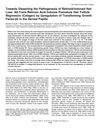TLDR Let-7b helps alpaca hair grow by reducing TGFβR I protein.
The study concluded that TGFβR I is a target gene of let-7b, and let-7b can regulate TGFβR I expression through transcriptional repression, thereby promoting alpaca hair growth. This finding was supported by experiments involving three young male alpacas, where real-time PCR showed that TGFβR I abundance in ear skin was 7.988 times higher than in back skin. The research highlighted the role of the TGF-β/Smads signaling pathway in hair follicle regulation and was funded by grants from The National Natural Science Foundation of China and the Shanxi Agricultural University Research Startup Project.
 92 citations
,
June 2005 in “Journal of Investigative Dermatology”
92 citations
,
June 2005 in “Journal of Investigative Dermatology” All-trans retinoic acid causes hair loss by increasing TGF-β2 in hair follicle cells.
 190 citations
,
October 2002 in “The FASEB journal”
190 citations
,
October 2002 in “The FASEB journal” Androgens may cause hair loss by increasing TGF-beta1 from scalp cells, which inhibits hair cell growth.
37 citations
,
July 1999 in “The EMBO Journal” Overexpression of certain genes can shorten hair by disrupting the hair-growth cycle.
140 citations
,
December 1998 in “Journal of Investigative Dermatology” Apoptosis in hair follicles varies by growth phase, with TGF-β possibly starting the catagen phase.
 12 citations
,
October 2021 in “Cells”
12 citations
,
October 2021 in “Cells” Targeting a protein that blocks hair growth with microRNAs could lead to new hair loss treatments, but more research is needed.
 11 citations
,
October 2021 in “Frontiers in Cell and Developmental Biology”
11 citations
,
October 2021 in “Frontiers in Cell and Developmental Biology” Non-coding RNAs are important for hair growth and could lead to new hair loss treatments, but more research is needed.
19 citations
,
January 2023 in “Frontiers in Bioengineering and Biotechnology” MSC-sEVs may effectively treat chronic non-healing wounds.
 18 citations
,
December 2020 in “Frontiers in cell and developmental biology”
18 citations
,
December 2020 in “Frontiers in cell and developmental biology” miR-140-5p in certain cell vesicles helps hair growth by boosting cell proliferation.
17 citations
,
November 2023 in “Journal of Biological Engineering” Antler stem cell exosomes improve wound healing and reduce scarring.




